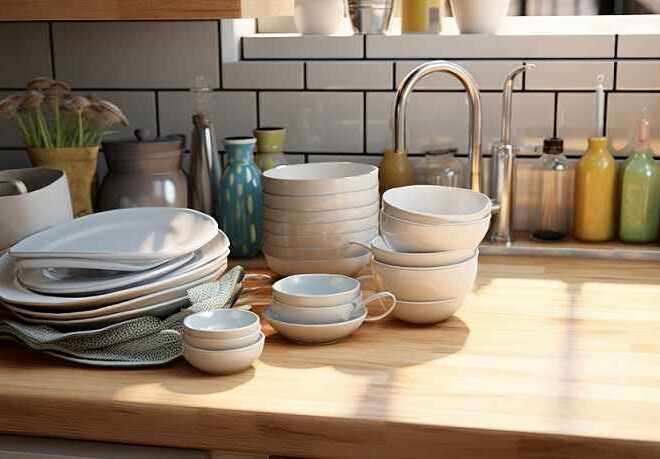
Measuring Your Kitchen Sink: Tips and Tools You Need for Success
Welcome to the ultimate guide for every home chef and DIY enthusiast! Whether you’re planning a kitchen remodel, replacing your old sink, or simply curious about maximizing your workspace, measuring your kitchen sink accurately is crucial. It’s not just about fitting a new fixture; it’s about transforming your cooking oasis into a functional masterpiece. From choosing the right tools to understanding essential dimensions, our handy tips will ensure you get it right the first time. Get ready to dive into the world of measurements with confidence—because a well-measured sink can make all the difference in creating that dream kitchen you’ve always envisioned! Let’s roll up our sleeves and get started!
When it comes to kitchen renovations, one of the most crucial steps is measuring your kitchen sink accurately. It might seem like a simple task, but getting those dimensions right can make or break your entire project. A well-fitted sink enhances not only functionality but also the overall aesthetics of your kitchen space. Imagine ending up with a gorgeous new countertop and backsplash, only to find that your chosen sink doesn’t fit as intended—that’s a nightmare no homeowner wants to face! With just a bit of preparation and the right tools in hand, you can navigate this process smoothly. Let’s dive into why proper measurements are essential and how you can achieve them effectively.
Why Accurate Measurements Matter
Accurate measurements are essential when it comes to selecting the right kitchen sink. A mismatch in size can lead to a range of problems, from poor aesthetics to functionality issues.
Imagine investing time and money into a beautiful new sink only for it not to fit your space correctly. This could result in costly modifications or even needing an entirely new unit.
Additionally, precise measurements help ensure that plumbing connections align seamlessly. Misalignment can cause leaks and other maintenance headaches down the road.
Proper sizing also plays a crucial role in your daily routines. An ill-fitting sink might limit how you use your kitchen, affecting everything from washing dishes to meal prep.
Ultimately, getting those numbers right sets the foundation for a successful kitchen upgrade, enhancing both style and efficiency in one of the most important areas of your home.
Tools Needed for Measuring Your Kitchen Sink
To measure your kitchen sink accurately, having the right tools on hand is essential. Start with a reliable tape measure. A flexible measuring tape allows you to navigate around corners and curves easily.
Next, consider a notepad or digital device for jotting down measurements. Keeping track of numbers helps prevent confusion later.
A level can also come in handy if you’re looking to assess how your current sink sits within its space. If it’s uneven, adjustments may be necessary for the new installation.
Additionally, a straight edge ruler can assist when checking depth measurements against cabinet height or countertops.
Lastly, grab some painter’s tape. Marking out dimensions directly on surfaces gives you a visual reference before making any purchases. With these tools ready, you’ll set yourself up for success in finding the perfect kitchen sink fit.
Step-by-Step Guide on How to Measure Your Kitchen Sink
Measuring your kitchen sink accurately is essential for a successful remodel. Start by gathering your tools: a tape measure, pen, and paper.
Begin with the width and length. Measure from the outer edge of one side to the other, ensuring you account for any overhanging edges. Write these numbers down carefully.
Next, assess the depth of your sink. Measure from the top rim to the bottom of the basin. This will help determine how much space you’ll need underneath for plumbing.
Don’t forget about faucet holes! Measure their diameter and spacing if you’re planning on installing new fixtures. Understanding where these features sit can save you headaches later on.
Lastly, consider any additional features like drainboards or integrated trays that could affect sizing options in your kitchen layout.
Measuring the Width and Length
To measure the width and length of your kitchen sink, start by clearing the area. Remove any items that might obstruct your view or access to the sink.
Use a tape measure for accuracy. Begin at one edge of the sink and stretch it across to the opposite side to determine the width. Make sure you note down this measurement clearly.
Next, measure from the front edge of the sink to its back wall for length. Keep an eye on where your countertop starts; measuring accurately here is crucial.
If you have a farmhouse-style or undermount sink, ensure you account for their unique shapes during measurement. This attention to detail will help avoid surprises later on when choosing a replacement or new installation options in your kitchen remodel project.
Measuring the Depth
Measuring the depth of your kitchen sink is crucial for ensuring it fits perfectly into your space. Start by using a tape measure to determine how deep the basin goes from the rim to the bottom.
Position one end of the tape at the highest point on the edge and extend it straight down to where water would typically pool. This measurement will help you understand if your chosen sink can accommodate large pots or if it’s too shallow for everyday tasks.
Remember, any obstructions beneath your countertop could affect this depth measurement. Knowing these specifics helps prevent installation headaches later. It can also guide you in selecting a faucet that complements both style and function without clashing with other elements in your kitchen design.
Measuring the Faucet Holes and Other Features
Measuring the faucet holes is crucial for a seamless installation. Start by identifying how many holes your sink has. Common configurations include single, double, or even three-hole setups.
Use a measuring tape to determine the distance between each hole center. This spacing will guide you in selecting the right faucet and accessories that fit perfectly.
Don’t forget to assess other features like soap dispensers or water filters. If your kitchen sink comes with additional attachments, measure their required space too.
Consider any clearance needed above the sink for handles or spouts as well; this can affect both function and style.
Every detail matters in achieving an efficient kitchen layout that complements your design vision while ensuring functionality.
Common Mistakes to Avoid When Measuring a Kitchen Sink
When measuring your kitchen sink, accuracy is key. One common mistake is forgetting to measure both the width and length separately. Ensure you account for the sink’s shape; some may appear larger than they really are.
Another frequent error involves neglecting depth measurements. A deeper sink can affect cabinet space or plumbing installation. Always use a straight ruler or tape to gauge this accurately.
Additionally, don’t overlook any existing fixtures like faucet holes or drain placements. These dimensions are crucial in determining compatibility with your new sink.
Finally, remember that measuring at an angle can throw off your results significantly. Keep everything level and straight for precise figures. Taking these simple steps will help avoid costly miscalculations in your kitchen renovation project.
Benefits of Accurate Measurements for Your Kitchen Remodeling Project
Accurate measurements can make or break your kitchen remodeling project. When you know the precise dimensions of your space, it helps in selecting the right kitchen sink that fits seamlessly.
A well-measured sink enhances functionality. It ensures adequate space for washing dishes and preparing food without feeling cramped.
Additionally, correct measurements prevent costly mistakes. Choosing a sink that’s too large can lead to installation issues or even require structural adjustments.
With accurate data at hand, you’ll also have better design options. Whether opting for an undermount or farmhouse style, precision allows you to visualize how everything will come together beautifully.
Lastly, knowing exact sizes aids in coordinating with other elements like countertops and cabinetry. A cohesive look not only elevates aesthetics but also increases your home’s value down the line.
Tips for Choosing the Right Size Sink for Your Kitchen
Choosing the right size kitchen sink can significantly enhance your cooking space. Start by evaluating your countertop dimensions. A sink that’s too large may overwhelm a small area, while a tiny sink in a spacious kitchen could look out of place.
Consider your daily activities. If you often wash large pots and pans, opt for a deeper or wider model. Conversely, if you mostly handle smaller items, a compact design might suffice.
Think about the number of users in your household. Larger families typically benefit from bigger sinks to accommodate frequent use.
Also, factor in storage needs beneath the sink. Ensure there’s enough clearance for plumbing and other necessities without sacrificing valuable cabinet space.
Finally, explore different styles like single-basin or double-basin options based on how you prefer to work in the kitchen. Your choice should marry functionality with aesthetics seamlessly.
Conclusion: Take the Time to Measure Correctly for a Successful Kitchen Upgrade
Taking the time to measure correctly for your kitchen sink can make all the difference in your kitchen upgrade. Accurate measurements ensure that you choose a sink that fits perfectly within your space, complements your design, and functions well with other fixtures. A little patience and attention to detail during this process will save you from potential headaches down the line. Embrace these tips, use the right tools, and you’ll find selecting the perfect kitchen sink becomes a smoother experience. Investing effort into proper measuring now leads to a more successful remodel later on. Happy renovating!


